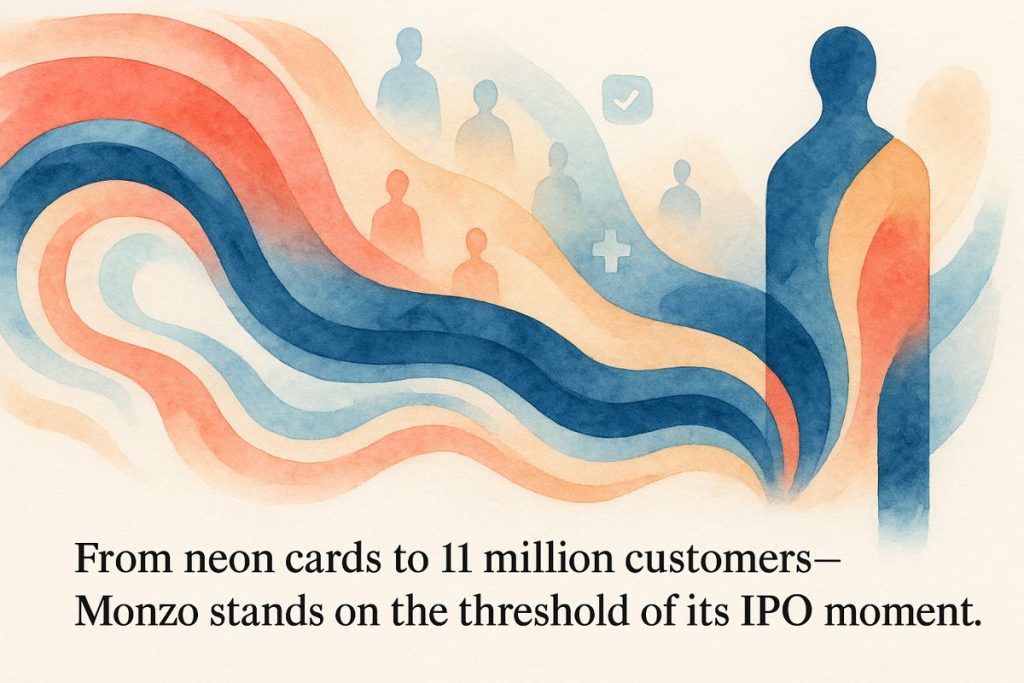Monzo became profitable in 2024 and now serves over 11 million people. Monzo began in 2015 with bright neon cards and a super-easy banking app, quickly winning over millions in the UK. Against tough odds and lots of doubts, the bank is thinking about going public, but can’t decide between a London or New York stock market listing. Monzo’s journey wasn’t all smooth—there were leadership changes, regulatory challenges, and tough questions about making money. Still, its mix of cool tech and friendly service turned Monzo from a hipster fad into a banking powerhouse, and now everyone’s watching to see what happens next.
What is Monzo’s journey from fintech startup to IPO contender?
Monzo, launched in 2015 with its iconic neon cards and user-friendly app, has grown into a leading UK digital bank with over 11 million customers. Achieving profitability in 2024, Monzo now eyes a major IPO, weighing options between London and New York stock exchanges.
From Hot Coral to Household Name
Remember the first time you saw a Monzo card? That retina-searing neon—hot coral, not orange, as every fintech hipster was quick to correct you—was impossible to ignore in any London pub queue. I confess, I assumed it was a passing fad, destined to fade like so many vaporwave startups. But here we are. In 2025, Monzo isn’t just the cult favorite of the avocado toast generation; it’s become an institution in its own right, a sort of digital palimpsest layered atop the UK’s fusty banking tradition.
Founded in 2015, Monzo built its early mythos on zero-fee spending abroad and a user interface so friendly it practically winked at you. By 2025, they’d not only weathered the initial tempest of growth but had cannily refactored their business model to suit the changing regulatory zeitgeist. I mean, one in five UK adults now has a Monzo account. That’s not just market share—that’s cultural infiltration, the kind that leaves a faint electronic whiff of possibility in every high street cafe.
Still, it wasn’t all confetti and emojis. Regulatory scrutiny thickened. Founding CEO Tom Blomfield departed. Even Monzo’s iconic Twitter banter couldn’t paper over existential questions about profit and scale. The company’s journey from upstart to established player was more Möbius strip than straight line.
Chasing Profit in a Sea of Skeptics
If you’d told me in 2020 that Monzo would post an annual net profit within five years, I’d have bet you a flat white and a cinnamon bun (not cheap in Shoreditch) that it was a pipe dream. Yet under CEO TS Anil, who stepped in just as the fintech wind was picking up a bitter chill, Monzo emerged blinking into the sunlight of profitability: £15.3 million in net profit on £880 million in revenue for the 2024 financial year (Wikipedia). That’s a turnaround worthy of a case study in the Harvard Business Review, or at least a punchy thread on Finextra.
What changed? For one, Monzo diversified beyond the sugar rush of interchange fees. Subscription tiers, business banking, and lending products now anchor its financials. Like a chef learning to balance umami, salt, and crunch, Monzo learned to blend revenue sources. The result: over 11 million personal customers and 600,000 business accounts by early 2025—a number that hums with the buzz of a data center at peak load. I have to admit, there’s a quiet awe in watching a digital disruptor become “the establishment.” Or is it nostalgia?
There was a hiccup, though. In 2023, Monzo’s valuation sat at £4.5 billion, which left some early evangelists grumbling at the pub about unicorn fatigue. But the IPO drumbeat is growing louder, with analysts whispering of a £6–7 billion valuation once shares finally hit the market. I’ll admit, the scent of ambition here is almost as heady as the aroma of burnt espresso at an all-night hackathon.
IPO: London, New York, or Somewhere In-Between?
Here’s where things get positively Dostoyevskian. Monzo, now “IPO ready” by end of 2025 according to industry tea leaves, faces a delicious existential dilemma: to list in London, bolstering Britain’s tech credentials, or to chase the liquidity and panache of a New York debut. CEO TS Anil reportedly leans toward New York. The board, meanwhile, seems to favor a homegrown listing—perhaps lured by the promise (or illusion?) of revitalizing the London Stock Exchange’s reputation for innovation (Payment Expert). Morgan Stanley’s involvement is all but official, like the telltale signature of a master forger on a Renaissance palimpsest (Fintech Weekly).
In the midst of all this, I had to stop and ask myself: can an IPO really capture the magic of a company built on community, memes, and a certain irreverent swagger? Or will the act of going public sand off the edges that made Monzo Monzo in the first place? There’s a whiff of trepidation in the air, mixed with anticipation—think ozone before a summer storm.
I remember the night I lost my Monzo card after one too many pints. Freezing it from my phone felt like magic. But when I called customer support, a real human answered in under a minute and even laughed at my “emergency kebab” story. That blend of hyperspectral tech and warm, human service has always been Monzo’s secret sauce. I wonder how it will taste in a post-IPO world.
Technology, AI, and the Unfinished Symphony
Even as it scales, Monzo has kept one foot planted in the hacker’s basement. Early on, their OAuth-based API set
